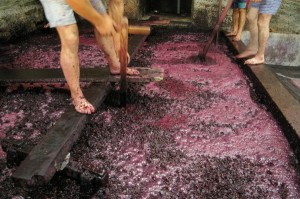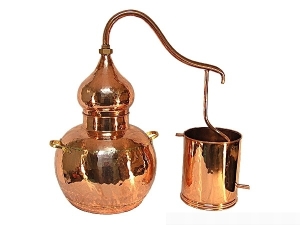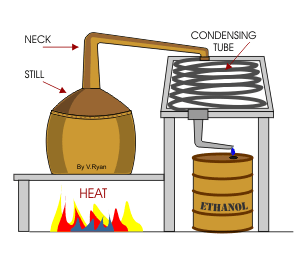Fermentation vessel in Portugal’s Douro
Al-ambic or Alembic Still used to distill fermented liquid
Fermentation is a process used to convert milk to yogurt or cheese (lactic fermentation), the making of bread, wine and beer For fermentation to occur an organism converts carbohydrates such as a sugar or a starch into acid or alcohol. For example, such organism can be yeast, which is a single cell organism that breaks down complex molecules (consumes sugars) and generates heat, and expels CO2 and Ethel Alcohol. To produce Ethel alcohol (what we drink) and CO2 the most important carbohydrate is glucose, a simple sugar that is metabolized by nearly all known organisms. What is important to know is that the basis for all fermentation is sugar, for example, grapes, are high on glucose and yeast is naturally present in their skins. Cultured yeast can be added to further control the fermentation process.-the addition of yeast or enzymes depends on the raw material used. The process of fermentation needs to be done in the absence of oxygen, otherwise ethanol is oxidized to acetic acid, the substance we commonly associate with vinegar.
The two basic sources of fermentable sugars to produce ethel alcohol are sugar rich ingredients such as grapes, sugar beets, and sugarcane; and starch-base ingredients like potatoes, agave, and grains. Depending on the source material used for fermentation, you might end up with a wine or a beer. These materials need to be processed by milling, cooking, mashing, crushing or steeping in water. The yeast is introduced, and the conversion of sugar begins. Fermentation continues until the level of concentration is enough to stop yeast growth. This normally happens when the alcohol content is 10% to 14%. In order to really increase the level of alcohol the process of distillation proves to be most effective. Other methods besides distillation are enrichment/chaptalization and concentration, but these only gradually increment the alcohol percentage and produce harsh liquids and retains all the byproducts of fermentation.
Distillation of fermented products produces a distilled beverage with high alcohol content or separates out other fermented products of commercial value. In simple language the liquid is boiled at a specific temperature (alcohol evaporates at 173º F), and the vapor rises and is channeled into a cooling coil, re-condensing back into liquid. This liquid has all the concentration of alcohol that was present in the original fermented liquid.
Cuts are the points in a distillation run where the stiller separates the distillate into separate fractions (divisions between sections of the run). In order to make good cuts, it is important to understand what the different fractions of a run are, and how to recognize them. There are three sections to consider the fore shots, the middle cut and the feints. The fore shots or head is the first part to come out of the cooling coil, is light but contains the most toxic impurities called congeners. This fraction should never be recycled but it has some other commercial uses. The middle cut is the heart and the purest section of the run, clean tasting, and smelling but good flavor. The middle cut will be bottled or barreled. The tails or feints is bland without much character, and tends to be recycled again with the heads into the next batch. Tails are rich in fusel oils, which cause unwanted tastes in your product.
For more info in cuts click here
By the way, not all congeners are bad news even though some might have damaging consequences to the body and the usual hangover, but these also give the distillate its unique flavors and aromas. Congeners occur naturally or can be added to the still when aging or barreled. For example some bourbons-aged in oak barrels have 37 more time the congeners present in vodka.



